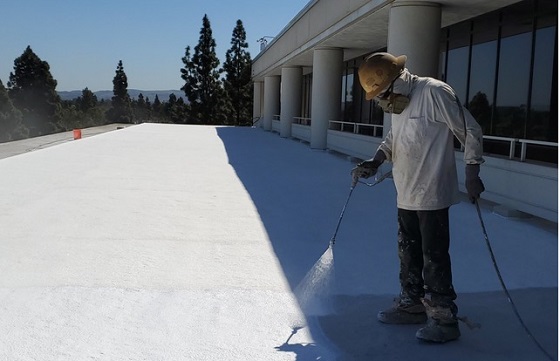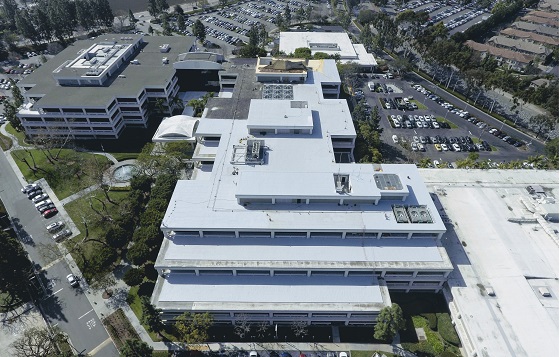When you first began driving, you may have heard the advice, “If you get into any trouble, call AAA.” The American Automobile Association, formed in 1902 in Chicago, is now known simply by its acronym, AAA. It’s so well known that membership is often given as a gift to friends and relatives.
The organization has come a long way over the years. From an initial membership of 1,500, AAA now has more than 58 million members in the United States and Canada. Just one of the company’s many corporate regional offices — this one in southern California — operates in a huge four-story facility located in Costa Mesa, Calif.
The southern California AAA regional building, which is managed by Cushman and Wakefield, has a rooftop surface totaling 100,000 square feet (9,290.3 m2). By 2019, its surface needed some TLC. It had reached the end of its useful life and needed to be restored.
Cushman and Wakefield reached out to General Coatings Manufacturing Corp., a manufacturer of spray polyurethane foam (SPF) and coatings for roof restoration. After performing a bid walk of the roof, General Coatings recommended a contractor they knew could handle the massive job: K & L Roofing, Inc. out of Corona, Calif., about 30 miles (48.3 km) from Costa Mesa
—
a distance that, with California traffic, is no joke to drive each day to get to work.
A Strong Vacuum
Luis Gonzalez, owner of K & L, enlisted a third party to perform an infrared moisture survey of the entire roof, by which the roof was determined to be a good candidate for a coated SPF application. “Actually, we got some good results,” Gonzalez recalled. “There was no moisture between the roofing layers.”
Add to that the fact that no repairs were necessary. Gonzalez said, “The roof was in pretty good shape. We just vacuumed it, and the deck was good to receive the new roof. We didn’t do any repairs.”
Beginning in December 2019, K & L subcontracted with Klondike Construction Services to vacuum the roof gravel and debris from the roof. “Usually, we had about 10 people there,” said Gonzalez. “When they were doing the cleanup at the beginning, there were probably 16, 18 because we had the crew cleaning and the guys doing the roofing work. But after the cleaning, it was just 8, 10 guys.”
And this was no household vacuum, of course, that was used on the AAA roof. “They used an industrial vacuum,” Gonzalez stated. “It’s a very big machine with a 6-inch [15.2 cm] hose. They vacuumed everything. The machine is strong enough to take all the dust and gravel from the roof.”
A Net House
With the roof cleared of gravel and debris, it was time to begin applying the primer. The crew spray applied General Coatings Ultra-Bond 10 acrylic emulsion primer at a rate of 1/3 gallon (1.3 L) per each 100-square-foot (9.3 m2) area, aka a roofing square. This application was done with a Graco GH 833 gas hydraulic sprayer.
Because the building remained operational during the entire roof restoration, and because the building is so large, there were a lot of people and cars around. It was especially important to protect the surroundings from overspray. Gonzalez described the tactic that was used to help keep overspray to a minimum: “What we did on this job, because there were hundreds of cars — maybe thousands — we ended up building a pen, like a house covered with net. We put the spray guys inside that.”

This “house” was built on an aluminum frame, a lot like fence posts with a net enclosure. When Gonzalez was asked how big of an area this frame took up, he said, “It was about was 8 feet [2.4 m] high, and it was 12 feet [3.7 m] by 12 feet.” When it came time to move the frame to each new area to be coated, he had a procedure in place: “I put two people moving the house to keep us moving,” he said.
During the job, K & L Roofing posted a video on the company’s LinkedIn page showing what the net house looked like and how it was moved along as the job proceeded. “We just had to be very cautious and careful of our surroundings and make sure that we did our best not to interrupt their working operations,” added Gonzalez. And of course, keeping people’s cars free of overspray.
Layer Upon Layer
The K & L crew wore personal protective equipment (PPE) during the AAA job, including 3M half-face respirators, safety glasses, gloves, and Tyvek coveralls. Harnesses, lifelines, and anchor points as well as warning flags — all obtained from Grainger — were utilized. “We just used the warning flags 6 feet [1.8 m] from the perimeter edge, and every time without the flags we used a harness,” said Gonzalez. He also conducted weekly toolbox talks with his crew during the course of the two-month stint — “where we discuss the work conditions and processes for best safety practices,” he added.
Once the primer was down, the crew applied a 1.5-inch (3.8 cm) layer of SPF, also called spray foam: General Coatings’ Ultra-Thane 230, a 3-pound (1.4 kg) -density spray-in-place rigid monolithic polyurethane foam. “This type of material is pumped through a machine that we use,” said Gonzalez, indicating the two Graco Reactor E30 proportioner machines used on this roof project. “So there’s a hose going up the roof,” he continued.
Using the net house, the crew moved around the roof in stages. “The way we did it, because this was a big size job and you don’t want to let the material sit for too long…we had two or three different crews at the same time. One of them is doing, for example, the spray foam, and the next one is doing the coating behind them. That way we are covering everything. By the end of the job, everything is done at the same time.” Per Gonzalez, the crew completed up to 100 roofing squares per day.
Atop the SPF, a topcoat layer of General Coatings Ultra-Flex 1000 elastomeric acrylic was spray applied using the Graco 833 machines. This topcoat was put down at an average of 40 mils (1,016.0 microns) dry film thickness. Finally, while the topcoat was still wet, 40 pounds (18.1 kg) of No. 11 white roofing granules from General Coatings were broadcast into that topcoat per roofing square using a Roofmaster granule machine.
Smooth and Easy
Overall, the AAA roof was a relatively easy project for Gonzalez’s crew. There were a couple rain delays, but “this job went pretty smooth,” he said. “Other than the rain, everything went well, and we had good weather.”
Gonzalez recalled, “The only challenge we faced on this job was the cars, and like I said before, we built a net. There were two choices: cover all the cars or cover my spray guys. We built a room around my spray guys. It was easier.” K & L Roofing certainly found a clever way to do an A+ job on this AAA roof.
